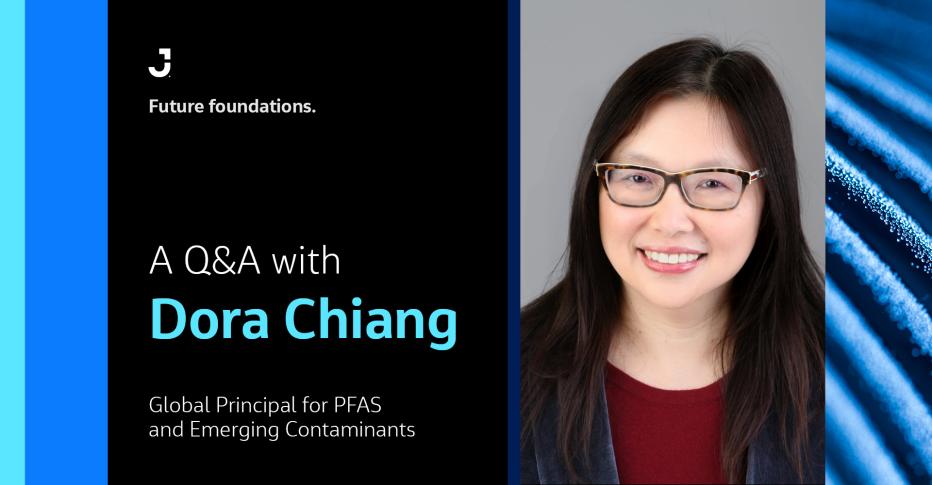A View on the Future of PFAS: A Q&A with Dora Chiang
Our Global Principal for PFAS and Emerging Contaminants explains how Jacobs is developing characterization, treatment and remediation solutions for per- and polyfluoroalkyl substances (PFAS) amidst a rapidly evolving regulatory environment

The scientific and regulatory landscape surrounding per- and polyfluoroalkyl substances (PFAS) is highly challenging.
PFAS are a large class of long-lasting, synthetic chemicals used extensively in industrial and household products. Manufacturing, use and release of products containing PFAS have resulted in their widespread occurrence in water, soil, air, plants and animals across the globe. Studies indicate that exposure to certain PFAS may also lead to adverse human and ecological health effects. As a result, PFAS regulatory limits in drinking water and the environment are rapidly evolving and increasingly stringent.
In this Q&A, we connect with Jacobs’ Global Principal for PFAS and Emerging Contaminants, Dora Chiang. Dora studied chemistry in Taiwan before pursuing a career in environmental engineering in the U.S. With more than 20 years’ experience specializing in environmental remediation and emerging contaminants around the world, Dora has deep technical and scientific expertise. Passionate about solving the global PFAS issue, Dora empowers clients to proactively address challenges and meet regulatory requirements.
What are the biggest challenges related to PFAS?
PFAS is a multidimensional issue impacting many industries and communities. Many PFAS are released as complex mixtures that can change over time, are highly mobile and do not degrade readily on their own. Assessing and investigating PFAS is therefore extremely complicated and traditional approaches for removing and destroying environmental contaminants have limited effectiveness when it comes to PFAS.
This complexity is leading to the introduction of stringent regulations. Failure to meet new PFAS regulations could potentially harm people, the environment or lead to litigation, financial liability and/ or reputational damage.
We know that releases of PFAS to the environment could come from numerous sources, including manufacturing and processing facilities, and secondary facilities using PFAS in production of other products—airports, oil and gas facilities, municipalities and military installations. While many of these sources recognize they need to prepare for potential regulations and are taking proactive measures, others, like small municipalities for example, are struggling to prepare as they don't have enough financial support to address the issue.
Helping clients address these multidimensional challenges is my mission. At Jacobs, we take a multifaceted approach to PFAS site characterization that combines our understanding of PFAS sources, chemical behavior, sampling and analysis, site characteristics and applicable regulatory considerations with client objectives. Our teams prepare solutions-oriented risk assessments and develop, test and design solutions for managing and treating PFAS in drinking water, environmental media, wastewater and biosolids, stormwater, landfill leachate and recycled water.
How do you help clients think differently to respond to future challenges?
Although complex, PFAS are not the first emerging contaminants so it’s important to stay pragmatic. When facing an issue, first you need to understand it and to do so you need to collect as much information and data as possible. While many jump ahead to collecting samples, I recommend clients first seek to understand how their organization uses and stores these kinds of materials and gather data which can inform a framework and strategy for addressing the PFAS problem. I also encourage clients to think about how they use the data they already have and apply that to this class of contaminants to understand how PFAS is going to migrate.
We work with clients to look at the challenge holistically, considering their full supply chain and identifying replacements to treat and reduce the release of PFAS into the environment. We’ve partnered with clients, academic experts and remediation vendors to develop and demonstrate innovative solutions for PFAS treatment, including in-situ and nature-based solutions.
There is a lot of research surrounding PFAS. Where do you see the industry heading?
When it comes to PFAS, knowledge really is power. PFAS structures are made up of several carbon-fluorine bonds—the strongest bond in chemistry. The unique chemical complexity of PFAS, combined with its widespread occurrence and associated challenges, have triggered a lot of research, largely focused on how to destroy these compounds. Ultimately, we hope PFAS can eventually be destroyed on site using destruction technology without moving away from the facility to mitigate waste and future waste receivers’ capacity issues. PFAS will remain “forever” chemicals if no action is taken.
In the next five years, I also expect to see further research into PFAS precursors. While regulation does not currently exist for PFAS precursors, we know precursors can impact the conversion into the regulated PFAS compounds, so it’s critical we understand how to monitor and manage precursors to further limit PFAS releases into the environment. The fate and transport of PFAS precursors and their transformation into regulated PFAS will need to be mapped out, otherwise the remediation efforts can be underestimated. Jacobs’ PFAS mapping tool models precursor behaviors.
What are the biggest opportunities ahead?
Despite the challenges, I’m optimistic about the future. We’ve already accumulated significant experience and encouraging case studies which demonstrate that while PFAS are not going away, you can address the issue by focusing on management and prevention.
Jacobs conducted one of the U.S.’s largest PFAS pilot programs to test and evaluate effectiveness of different types of media for removing PFAS from Orange County’s water supply. We supported the design of Orange County Water Basin’s pilot system and served as technical advisor during operation. We led the execution of treatability testing, including Rapid Small Scale Column Tests of granular activated carbon and novel adsorbents using well water from the impacted water sources. Testing led to multiple designs for two water producers—the City of Tustin and Golden State Water.
Our teams have also carried out PFAS analysis at 85 U.S. Naval bases and facilities, providing preliminary assessments, site inspections, remedial studies and residential drinking water analyses. We used solute transport modeling to assess future exposures and thermal imaging to improve sediment sampling.
Combining aggressive source reduction with nature-based solutions for plume management can mitigate the issue at scale. While PFAS have penetrated social media, public scrutiny and fear of “forever chemicals” could mask the important progress made on solutions—promoting technology adoption and prioritizing education and communication with clients are critical if we’re to deliver on our mission.
What do you hope to achieve in the next five years with Jacobs?
Innovation is part of my DNA and I’m excited to expand Jacobs’ digital solutions. Our patent pending PFAS Evaluation Toolset already informs source identification and site management decisions, using geographic information system (GIS) information to communicate potential and actual sources of PFAS risk levels via smart graphics. Jacobs’ Sample Results Viewer provides our remediation professionals with instant access to results in an interactive, web-based geospatial interface. We’re now exploring how we can use machine learning to glean even deeper insights from the data collected and the clients’ supply chain to provide more accurate and precise information so they can prioritize actions to reduce the risk most significantly.
The lessons learned from PFAS will influence how we look at the next school of emerging contaminants. Personally, my colleagues and I are eager to fully understand microplastics, which have similar characteristics to PFAS, but unlike PFAS – which need to be collected and identified in a lab – are visible to the naked eye. Regulation, if developed, will have to be based on size, which is a new approach, but given what we’ve achieved in relation to PFAS, I’m excited to go further.
About the interviewee

Dora received both a bachelor’s and a master’s degree in chemistry while living in Taiwan before completing a master’s degree in environmental engineering at Illinois Institute of Technology and further advancing her knowledge with a PhD in the same field from Georgia Institute of Technology. Bilingual in English and Chinese and experienced in working on projects around the world, Dora is committed to helping clients and communities proactively address the challenges related to PFAS and emerging contaminants.
Future Foundations.
Co-creating the world to come

From developing climate resilience and transitioning to a low-carbon future, to modernizing and transforming infrastructure, governments and businesses face critical challenges. How they respond will define our future.
As our clients navigate these challenges, we help them think differently – working together to pioneer tomorrow's infrastructure solutions and build the foundations for a prosperous, secure future.














































